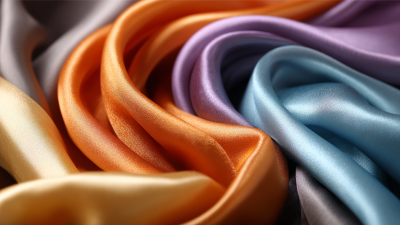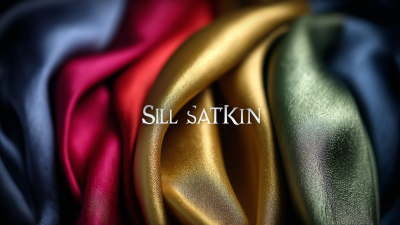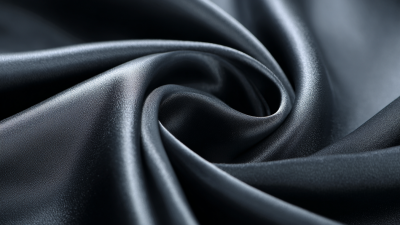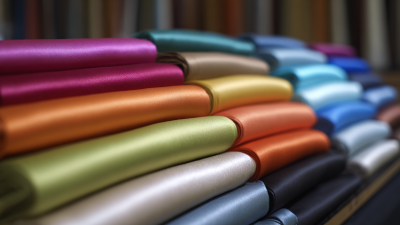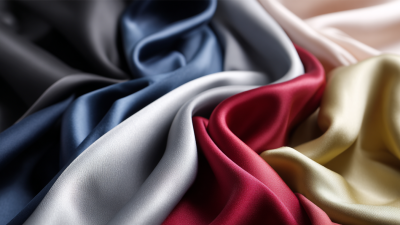The silk satin fabric has long been a staple in the fashion industry, known for its luxurious appearance and smooth texture. According to a report by Grand View Research, the global silk market is expected to reach $18 billion by 2025, driven by the rising demand for high-quality fabrics in fashion lines. Choosing the perfect silk satin fabric is essential for designers looking to create elegant and sophisticated garments that stand out in a competitive market. The unique characteristics of silk satin, such as its luster and drape, make it an ideal choice for evening wear, bridal collections, and high-end fashion apparel. Understanding the different types of silk satin, their applications, and how to select the right fabric for your line can significantly elevate your designs and appeal to discerning customers.
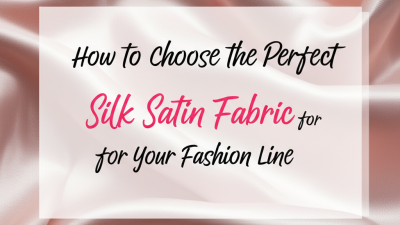
When selecting silk satin fabric for your fashion line, it's crucial to understand the various types available and their specific uses. Traditionally, silk satin is categorized into several grades, including charmeuse, crepe satin, and chiffon satin.
Charmeuse features a luxurious, glossy surface with a soft, flowing drape, making it ideal for evening gowns and elegant blouses. On the other hand, crepe satin has a textured surface that adds dimension, perfect for structured designs like tailored jackets or sophisticated skirts.
Additionally, considering the weight and thickness of the fabric is essential for your intended designs.
Lightweight satin offers a delicate flow, which is fantastic for summer dresses or flowing maxi skirts. Conversely, heavier satin provides more structure, making it suitable for evening wear with elaborate designs and embellishments. Understanding these distinctions allows designers to choose the right silk satin that aligns with their vision and enhances the overall aesthetic of their collection.
When choosing silk satin fabric for your fashion line, it's essential to consider several critical factors that influence both the design and marketability of your collection. According to a report by Statista, the global textile market is projected to reach $1 trillion by 2025, highlighting the importance of selecting high-quality materials that align with consumer trends.
One of the primary factors to consider is the fabric's weight and drape. Silk satin comes in various weights, typically measured in grams per square meter (GSM). For designs that require a luxurious flow, opting for a heavier GSM (between 80 to 120) can provide an elegant drape, while lighter options (around 60 GSM) are suitable for more structure-oriented styles.
**Tip:** Always request fabric swatches before finalizing your choices to understand how they will behave in real-world applications.
Another pivotal aspect is the color and finish of the silk satin. Market research shows that vibrant colors are surging in popularity, especially among younger consumers. Selecting shades that resonate with your target demographic will enhance your collection's appeal. Additionally, consider the sheen of the fabric; a higher gloss finish can elevate the perceived luxury of your designs.
**Tip:** Leverage color trend reports from sources like Pantone to stay ahead of emerging hues that will attract buyers.
When selecting silk satin fabrics for your fashion line, it's crucial to understand how to identify high-quality materials. According to a market analysis by Grand View Research, the global silk fabric market is expected to reach USD 1.35 billion by 2026, reflecting the growing demand for luxurious textiles. Quality silk satin fabrics should have a smooth, luxurious finish that drapes beautifully. Look for a fabric with a tight weave, as this indicates better durability and a more refined appearance.
**Tips:** Always check the fiber content; pure silk is a must for outstanding luster and feel. Additionally, examine the fabric's weight; a heavier satin typically suggests higher quality, allowing it to hold structure without being flimsy.
Moreover, you should conduct a burn test—true silk will burn slowly and leave a fine ash, while synthetic blends may melt or emit harmful fumes. Market insights show that direct sourcing from reputable suppliers can ensure you receive premium quality and authenticity. Aim to build relationships with providers who offer certifications and adhere to ethical practices, as this will enhance your brand’s value.
**Tips:** Look for certified suppliers who can demonstrate transparency in their sourcing methods. Investing in high-quality silk satin not only elevates your designs but also aligns your brand with consumer expectations for sustainability and quality.
When selecting silk satin fabric for your fashion line, the choice of color and pattern plays an essential role in capturing consumer attention and establishing your brand identity. According to the 2021 Global Color Trends Report, color influences 85% of purchasing decisions, making it crucial for designers to understand the psychological impact of their color choices. For example, warm tones like reds and oranges are often associated with excitement and passion, which can drive impulse buys, while cooler shades like blues and greens can evoke feelings of calmness and trust.
Patterns also significantly affect consumer perceptions and purchasing behavior. A 2022 study published by the Fashion Institute of Technology found that 68% of consumers are drawn to clothing with unique patterns, such as florals or geometric designs, which can elevate a simple silk satin piece into a statement garment. Furthermore, incorporating timeless patterns such as stripes or polka dots can enhance the longevity of a collection, appealing to consumers looking for versatility in their wardrobe. Thus, when curating your silk satin choices, consider both color and pattern not just as aesthetic elements, but as strategic tools that resonate with your target audience.
| Fabric Type | Color | Pattern | Weight (GSM) | Usage |
|---|---|---|---|---|
| Silk Satin | Rich Red | Solid | 90 | Evening Gowns |
| Silk Chiffon Satin | Soft Pastel Pink | Floral Print | 80 | Dresses |
| Double-sided Silk Satin | Deep Blue | Geometric | 95 | Tailored Suits |
| Luxury Silk Satin | Emerald Green | Damask | 110 | Bridal Wear |
| Lightweight Silk Satin | Ivory | Stripes | 70 | Loungewear |
When selecting silk satin fabrics for a fashion line, sustainability should be at the forefront of every designer's mind. The rise of eco-conscious consumers has pushed many brands to seek out materials that not only enhance their designs but also minimize environmental impact. Eco-friendly silk satin can be sourced from producers who prioritize ethical farming practices and reduce harmful chemical use. Look for certifications such as Global Organic Textile Standard (GOTS) or OEKO-TEX to ensure that the materials align with sustainable practices, from the silkworms' care to the final product.
Additionally, consider alternative sources of silk, such as Peace Silk, which allows for the sustainable harvesting of silk fibers without harming the moths. This method not only supports animal welfare but also contributes to the well-being of the ecosystem. By incorporating these sustainable silk satin options into your fashion line, you can create luxurious pieces that resonate with today's consumers, allowing you to stand out in a competitive market while promoting a healthier planet. Emphasizing these eco-friendly materials in your collections not only enhances your brand's image but also aligns with the growing demand for responsible fashion.
